#Saint Wilgefortis
Explore tagged Tumblr posts
Photo
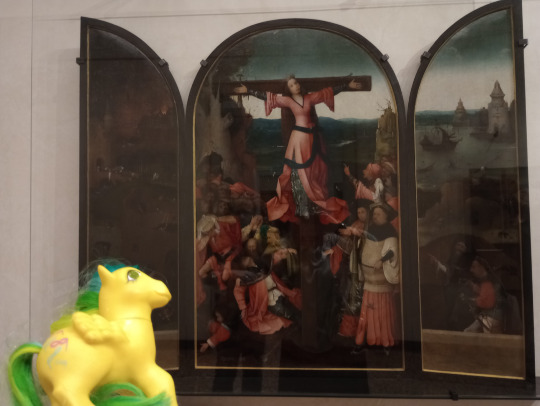

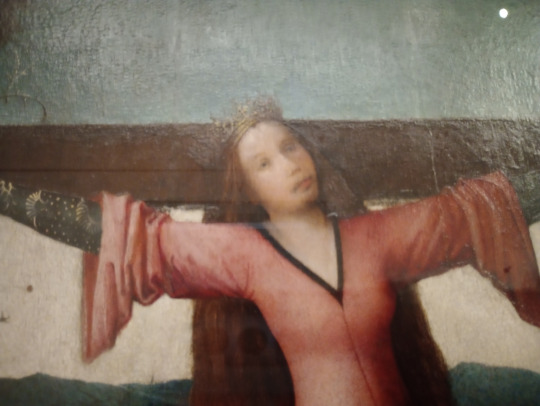

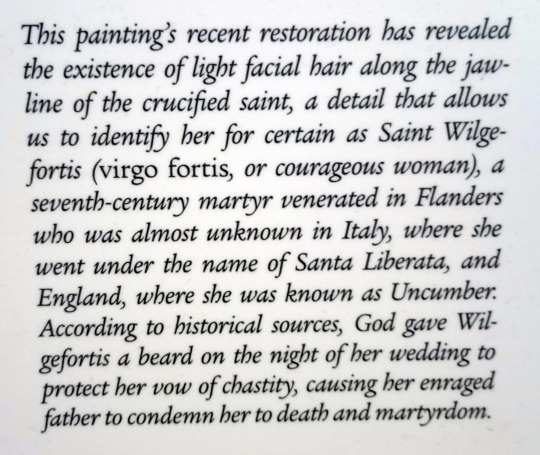
Masquerade is looking around Venice (and the surrounding islands).
In Italy.
Masquerade is looking at a painting by Bosch. In the Galleria dell’Accademia.
This is photo number 153 of 366.
#My Little Pony#g1#masquerade#venice#italy#galleria dell'accademia#Bosch#saint wilgefortis#uncumber#santa liberata
37 notes
·
View notes
Text
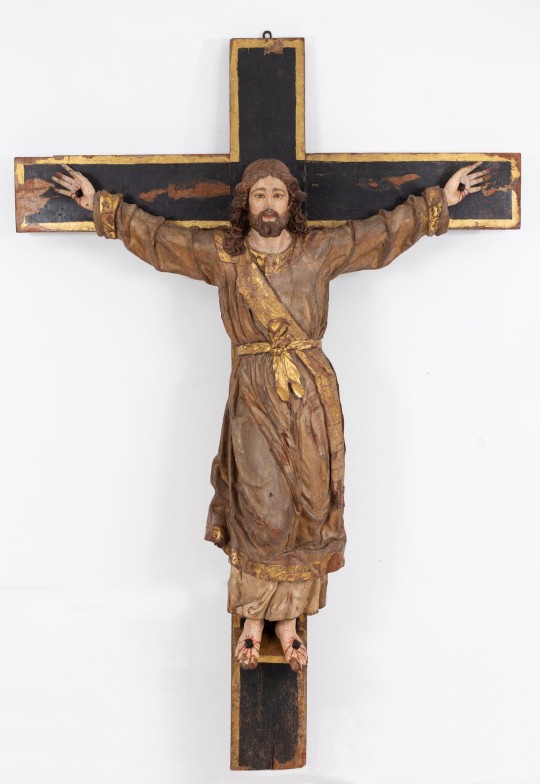
When Catalonia's National Art Museum (MNAC) acquired this piece, they thought it represented Jesus Christ on the cross. On a closer study, they realised it represents a woman: Saint Wilgefortis (Santa Lliberada in Catalan, which means "Saint Liberated").
This wooden sculpture was made by an artist called Andreu Sala around the year 1689 for the church of El Carme in Barcelona, Catalonia. But why does a female saint have a beard? This is not a shock to anyone familiar with this saint's story.
According to the legends, Wilgerfortis was the daughter of a pagan king of Portugal. She converted to Christianity in secret and made a vow of chastity. Her father gave her hand in marriage to a pagan or Moorish king, but she refused to marry anyone. To avoid marriage, she prayed to God to disfigure her to make men find her ugly. God answered her prayers and blessed her by making her grow a beard. The marriage was broken and that made her father angry. He accused Wilgerfortis of witchcraft and had her crucified, like Christ had been.
There are different hypothesis about the origin of this legend:
Some say it might be related to ancient intersex divinities, such as the Ancient Greek Hermaphroditus.
Others say it might have its origin in a side-effect of malnourishment that many nuns had. In convents, it was very common to fast (=not eat for long periods of time for religious reasons), so many nuns had hormonal imbalances that can result in growing facial hair.
The most widespread hypothesis seems to be that Saint Wilgerfortis and similar legends were created to re-interpret the Christs in Majesty that culturally didn't seem male anymore. Because of Byzantine influence, in the Romanesque period (11th-13th centuries), sometimes Christ on the Cross was represented wearing a long tunic tied at the waist and looking calm. After that period, Christ on the Cross was always represented half naked and suffering. They are so different that they look like different saints and the long dress fitted at the waist was associated with women at the time, so people who saw the old representations of Christ would assume it was a woman with a beard, and came up with legends to explain the beard.

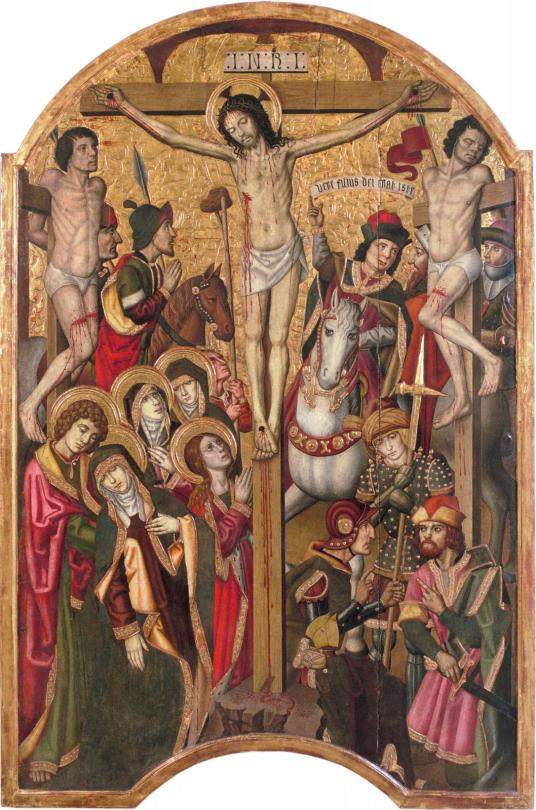
Here you can compare the two ways of representing Christ. On the left, the statue called Majestat Batlló, made in the 1100s in la Garrotxa (Catalonia) in Romanesque style. On the right, the Calvari painting made around 1470 in Granollers (Catalonia). Both of them are kept in MNAC.
There are some other saints with very similar stories to Saint Wilgefortis, like Saint Múnia of Barcelona.
Now you might be wondering, how do we know this statue represents Saint Wilgefortis and not Christ? First of all, this statue is from the Baroque period, where Christ was never represented wearing a long tunic and hadn't been for centuries. Culturally, it would not make any sense for a Catalan artist in the 1600s to represent Christ or any normative man wearing what by then was a woman's dress. Secondly, if you look at the statue from the side, you can see that she has some boobs. And lastly, when the statue was restored, they found a textile fragment at the bottom of the tunic, which was a stitching work made from lace. Traditionally, lace has been a type of decoration used in women’s clothing.
So there is no doubt that this statue, like others that can be found all around Europe, represents Saint Wilgefortis. The woman who was blessed with a beard, and who we call Saint Liberated because her beard liberated her.
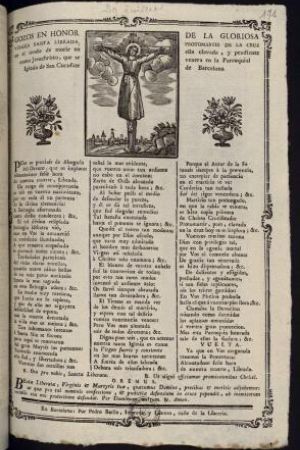

Couplets in honour of Saint Wilgefortis for the church Sant Cugat del Rec in Barcelona, Catalonia. 18th century. Source: Mediateques Montpellier. Here, the images represent her without a beard, but the poem explains her story.
Traditionally, Saint Wilgefortis has been patron saint of agriculture, travellers, children who were stunted or had difficulty walking, skin diseases, pets, laundresses, and the agony of the dying. In more recent times, two more were added: Saint Wilgefortis is the patron saint of transgender people and has been claimed as a lesbian martyr.
Source: Museu Nacional d'Art de Catalunya.
#arts#escultura#uselesslgbtfacts#mnac#baroque#saint wilgefortis#folk saint#trans#transgender#intersex#art history#trans history#museums#museum#history#història#catholiscism#catholic#eating disorder mention#religion
134 notes
·
View notes
Text

Hieronymus Bosch (c.1450–1516), The Crucifixion of Saint Wilgefortis (detail), c.1497, oil on panel
#art#painting#Hieronymus Bosch#The Crucifixion of Saint Wilgefortis#Saint Wilgefortis#The Bearded Lady#16th century#1500s#legend#Flemish art#Flemish artists#Netherlands#hypertrichosis#women in history#femininity
2 notes
·
View notes
Text
Also don't forget Saint Wilgefortis, a bearded lady saint who's probably based on Southern European depictions of Jesus in what more northern people interpreted as a dress.
Gender Nonconforming Jesus: A look at art history. CW: religion, transphobia, artistic nudity, depictions of open wounds (Long post)




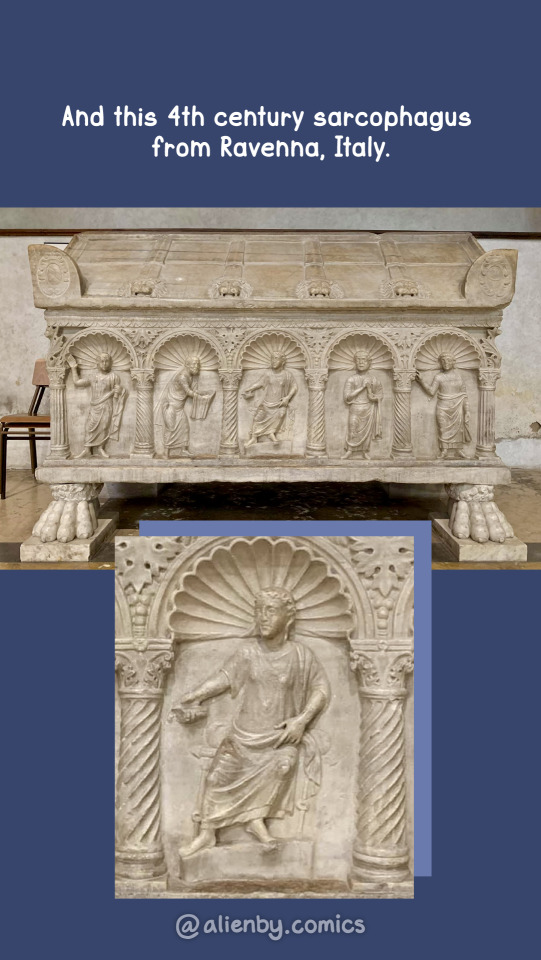


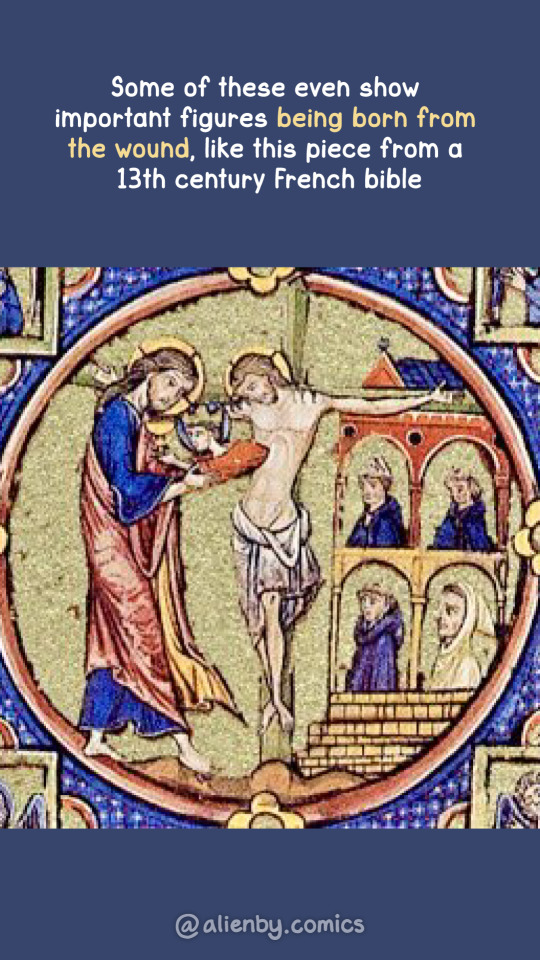






22K notes
·
View notes
Note
Hello! I want to nominate Saint Wilgefortis (or Liberate , or Débarras depending on the country) - she's the bearded saint, unofficial patron of the LGBT !
Also nominating Saint Francis of Assisi because come on. he's the best.
OHHHHH yessssss give me the lgbt icon saints! As an aside, though he's not a saint, one of my hopefuls is Fr. Mychal Judge. I really really really hope he's beatified someday!
And yes, St Francis is cool, but we'll have to let the poll decide if he's the best!
#st wilgefortis#st francis of assisi#all the saints#catholic saints#catholic saint tournament#tumblr tournament#tumblr bracket#polls#catholic#catholicism
10 notes
·
View notes
Note
Who do you think is the Saint of transitioning? Like, in general
perhaps either St. Marinos the monk or St. Wilgefortis... or even St. Joan of Arc, St. Thecla, St. Eugenia...
(Kittredge Cherry from qspirit.net has some very extensive lists!!!! also, i highly recommend her website. she's so cool <3)
#i think it all depends who calls most to you#i'd honestly think St. Marinos is the one that calls to me most#but idk#thoughts#anon#anon questions#ask away
79 notes
·
View notes
Photo



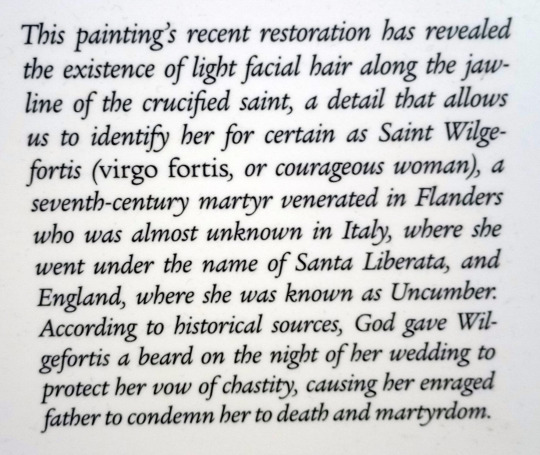

Masquerade is looking around Venice (and the surrounding islands).
In Italy.
Here is Masquerade in the Gallerie dell’Accademia.
This is photo number 64 of 366.
#My Little Pony#g1#masquerade#venice#italy#gallerie dell'accademia#bosch#saint wilgefortis#patting the pony artwork
22 notes
·
View notes
Note
Was the order of St Beryl's in Good Omens a reference to Bedazzled (1967)?
To Bedazzled and to Saint Wilgefortis.
495 notes
·
View notes
Text


In the STORIEL collection of Gwynedd Museum and Art Gallery in Bangor, there is a wooden figure, around two feet tall, made by a Flemish carver around the year 1520. It represents Saint Wilgefortis, and the story behind this sixteenth-century object encompasses bearded women, oppressed people and gender fluidity within religious iconography. Interpretations of Wilgefortis's legend disrupt the binaries of male and female, and the human and the divine. Taking a close look at the figure, the face has a high forehead, with arched eyebrows and downcast eyes that suggest a humble or contemplative expression. The person has long, curling hair and a short, neat beard. It seems that the clothing on this figure is particularly feminine: there are beads on a necklace, ruched folds of the undershirt at the neck, and a cinched waist with a floral motif in the middle. Seen from the side, the figure seems to have a bust. The feet are covered by a shroud tied loosely at the ankles. The folds of fabric and waves of hair suggest softness.

Saint Wilgefortis (details), c.1520, wood by unknown artist
No arms are visible, and a cloak covers the shoulders. The angle of the shoulders, raised up, suggests the arms may have been splayed out, like on a crucifix – perhaps they were broken off, as the rectangular holes at the sides attest. How did a Flemish object come to be in Wales? The collection website explains the item was originally owned by Captain John Jones, a master mariner who collected objects on his travels and set up his own museum in Bangor. In Europe, after the Protestant Reformation in the sixteenth century, many churches were stripped of decoration and these works of art were destroyed or even looted and sold, as part of the Beeldenstorm ('image storm'). This Flemish image of Saint Wilgefortis, usually venerated by Catholics, clearly didn't escape the looting. Also known as 'The Bearded Lady', Wilgefortis is known for her facial hair. The legend goes: the young Christian Wilgefortis was the daughter of the pagan King of Portugal, who arranged for her to be married to a suitor. The young woman, who had taken a vow of chastity, prayed to be made repulsive and released from the betrothal. Her prayers were answered in the form of a luscious beard. The new facial adornment put off the potential husband, and Wilgefortis's father was so angry that he had her crucified. Her story made her a popular saint with women who were in unhappy, abusive situations. The variations of her name across Europe echo parts of her tale: Saint Uncumber ('disencumbered'), Saint Ontkommer or Kümmernis ('ohne Kummer', without anxiety), Saint Liberata or Librada ('liberated'). Wilgefortis sounds also like virgo fortis ('courageous virgin' in Latin). [...]
[read more]
#art#sculpture#Saint Wilgefortis#The Bearded Lady#Christian Wilgefortis#legends#Saint Uncumber#Saint Ontkommer#Saint Kümmernis#Saint Liberata#Saint Librada#hypetrichosis#articles#ArtUK.com
1 note
·
View note
Text
A flyer that features this saint is being distributed and thrown at the far right groups and their allies (including a Catholic fundamentalist group) in the ongoing solidarity convention in front of the LGBTQIA+ community center in Vienna all because they invited a drag queen to read a children’s book, “The Paper Bag Princess” by Robert Munsch. The far right is demonstrating against transsexuals and drag queens most of all.

Saint Wilgefortis
Transphobia comes in all races and colours, but it worries me that a few of the outspoken Viennese women who are involved in psychoanalysis are transphobes. They gradually come out in light of these events that initiated by the socialist and green politicians in the 6th district. I hope I am only reading this side of the echo chamber on Twitter.
St. Wilgefortis

This 16th century polychromed wood sculpture is a rare image of the mythical St. Wilgefortis. According to folk tales, the father of a teenager named Wilgefortis promised her in marriage to a foreign king. To thwart the unwanted wedding, she took a vow of virginity and prayed to be made repulsive. She sprouted a full beard which ended the engagement. The father was so angry he had her crucified. In a nice dress. And wearing a crown, for some reason.
Photo by Charles Reeza at the church of Saint-Étienne in Beauvais, France
#transphobia#in#austria#saint wilgefortis#patron saint#against abusive husbands and partners#and transsexuals
13 notes
·
View notes
Note
Hi! I saw a post where you mentioned intersex Jesus being a part of medieval European alchemy and I'd love to learn more about that. Could you elaborate or maybe provide links to some articles? I know some saint mystics talked about Jesus being our Mother, and the holy wound in His side was often likened to a birth canal, especially in medieval times. Is it connected to that in any way?
I'd love to elaborate! (This is going to be a long post so buckle up lol)
I will be using the word "hermaphrodite" instead of "intersex" because that is the word that primary sources from medieval Europe and contemporary medieval scholars use when talking about this subject
The best scholarly article I've found is "The Jesus Hermaphrodite: Science and Sex Difference in Premodern Europe" by Leah DeVun. It talks about how the image of the hermaphrodite was used in a metaphorical way by alchemists to show the combining/transforming of two different metals. They believed that certain metals/elements were gendered, so combining male and female "traits" would make something of a completely new sex; similar to the way they perceived hermaphrodites as both but also neither sex.
The article then goes on to talk about two medieval texts: Aurora consurgens and the Book of the Holy Trinity. Aurora consurgens is an alchemic text and has the image below in it. The hermaphrodite is holding a rabbit and bat, both of which were thought to be hermaphroditic species where both males and females gave birth, to emphasize their dual sexuality as well as the conflicting male and female attributes of alchemy.

The Book of the Holy Trinity transitioned from the traditional alchemic hermaphrodite, like seen above, into the religious sphere by arguing that Jesus and Mary were two sides of the same coin. The author of the text says, "one can never see the mother of God without also seeing that God eternally hides and intermingles [his mother] within him. God was and is eternally his own mother and his own father, human and divine, his divinity and his humanity intermingled within. And he depends on that which he wishes to be hidden most of all within himself, the divine and the human, the feminine and the masculine." This makes Jesus/Mary a hermaphrodite.
As a bit of a fun side note to your ask, the author of the Book of the Holy Trinity gives a few more supporting points to his argument and then turns to say that as Christ contains Mary, He also contains the Antichrist which the Book illustrates like this:

The idea of the hermaphrodite Christ really took off after that and boosted the cult of Saint Wilgefortis, saint of monsters. Images of the hermaphrodite Wilgefortis were often indistinguishable from images of Christ because they were both depicted on a cross but where they both have beards, Wilgefortis only has one shoe on: a playful medieval illusion to female sex organs. Images of Saint Wilgefortis below (some images from the 1800s, some from the 1400s). You can read more about Wilegfortis in Bearded Woman, Female Christ: Gendered Transformations in the Legends and Cult of Saint Wilgefortis by Lewis Wallace.




About a hundred years later, “The Lamentation around the remains of Christ,” below, was made depicting Jesus with breasts and feminine curves. Not much is known about it and Christ's hermaphroditic traits weren't even discovered until it was restored in the 21st century. Because of how recent this discovery is, not much scholarly work has been published on it, but I did find this: "The androgyny of Christ" by H. Valdes‑Socin. It is now at the Museum of Notre-Dame à la Rose Hospital in Lessines, Belgium.

And you're absolutely right about Christ's stab wound being like a birth canal! I think the article Mysticism and queer readings of Christ’s Side Wound in the Prayer Book of Bonne of Luxembourg by Dr. Maeve K. Doyle does a good job of explaining it. Dr. Doyle says, "The image of the side wound, ... grants feminine bodily attributes to Christ, destabilizing assumptions about his gender. In mystical images and texts, Christ’s capacity to transcend the gender binary, like his capacity to transcend the binary of life and death, underscores his divinity." Dr. Doyle then goes on to talk about how images of the stab wound looking like a birth canal would also be comforting to medieval women, trans people, and homosexuals on both sides. Now I'm not Christian but I think it's really amazing that such a simple image can elicited so much comfort and joy in so many groups of people who were not able to fully be themselves in the era they lived in. It was a reminder that even Christ was like them, their feelings were valid (to an extent), and that Jesus loved them anyway. Medieval Jesus stab wounds below for people interested.



----
Just for fun here are some more cool things!

A medieval wooden architectural relief with a person with a beard, phallus, and breasts


Potta di Modena Metope/The Hermaphrodite (left) and detail from the Southern Archivolt (right) of the Modena Cathedral Modena, Italy, c. 1099-1319, Marble reliefs
The Potta di Modena Metope (left) is damaged because people in the 1500s thought it was too sexual/offensive so they vandalized it
More journal articles:
Bearded Women in Early Modern England by Mark Albert Johnston
The Third Sex: The Idea of the Hermaphrodite in Twelfth-Century Europe by Cary J. Nederman
Transvestites in the Middle Ages by Vern L. Bullough
#finally time to put my art history degree to use lol#history#art history#art#medieval#medieval art#medieval manuscripts#jesus#jesus christ#lgbt#lgbtq#queer#queer history#lgbt history#lgbtq history#alchemy#asks#i need to remember this
14 notes
·
View notes
Text

The Holy Face of Lucca (Italian: Volto Santo di Lucca) is an eight-foot-tall (2.4 m), ancient wooden carving of Jesus crucified in the cathedral of San Martino, Lucca, Italy. Medieval legends state that it was sculpted by Nicodemus who assisted St. Joseph of Arimathea in placing Christ in his tomb after the crucifixion. The same legends placed its miraculous arrival in Lucca to AD 782.
At the end of the fourteenth century, such a Holy Face inspired miracles and veneration in the Low Countries, Bavaria and the Tyrol, though its connection with Lucca had been forgotten. The long robe worn by the statue appeared to signify that the figure was of a woman. To account for the beard, a legend developed of a young noblewoman who miraculously grew a beard in order to maintain her virginity. Her father, often said to be the king of Portugal, promised her in marriage to another pagan king. Wilgefortis, who had taken a vow of perpetual virginity, prayed to be made repulsive to her future husband. As a result, she grew a long, flowing beard. In a rage, her father had her crucified. Wilgefortis became a popular figure in folk Catholicism. As a result, she assumed various local names including Kümmernis in Germany or Sainte Débarras in France, and was duly entered in the Martyrologium Romanum in 1583, retaining a devoted following as late as the nineteenth century.
8 notes
·
View notes
Text

St. Wilgefortis, pray for us
From Wikipedia: She is depicted in a full blue tunic with a substantial beard. She is venerated by the name of Santa Librada in Argentina and Panama.
She is often shown with a small fiddler at her feet, and with one shoe off. This derives from a legend, also attached to the Volto Santo of Lucca, of a silver shoe with which the statue had been clothed dropping spontaneously at the feet of a poor pilgrim. In Wilgefortis's version, the poor devotee became a fiddler, perhaps in the 13th century.
Because of her appearance, Wilgerfortis has been described as a "transgender saint" and is sometimes seen as an informal patron saint of persons who identify as gender fluid.
42 notes
·
View notes
Text
Today's queer saint of the day is St. Wilgefortis, a bearded lady and virgin martyr.
This cool poster was brought to my attention by a follower who spotted it in their local lesbian bar. It's an original design by Maïc Baxane, who has it available for purchase on their Etsy

Once upon a time, there was a young, beautiful woman named Wilgefortis (or Débarras, or Liberata, or Uncumber, or a variety of other names in European languages). Her father planned to marry her off to a cruel and impious king, so Wilgefortis prayed to God for deliverance. She grew a beard, and her would-be husband rejected her. Her father became so angry that he crucified her, but she went to heaven with Jesus, Mary, the angels, and the virgin martyrs of old.
This story may not be "true" in a historical sense (if it is, what "really happened" is obscured behind centuries of myth and legend). What is fascinating about St. Wilgefortis is how popular and widespread her cult was, and still is, with people on the margins. She is venerated by lesbians, trans women, chaste and asexual people, people fleeing misogynistic violence, intersex people, gender-nonconforming people, drag performers, sex workers, women with beards and men without them, and many many others. Her cult arose in the 14th century, but was oh-so-helpfully "debunked" by the Church a few hundred years later. In present times, St. Wilgefortis gets the last word, and she remains a patron saint for bearded ladies and the people who love them.
Read more about St. Wilgefortis here
45 notes
·
View notes
Text
Saint Pelagia of Antioch
Sorry for all the saints lol
Saint Pelagia of Antioch was also called Pelagia the Harlot, her feast day is the 8th of October
She lived as a monk under the name Pelagios for many years in the 4th or 5th century. until she died due to extreme asceticism (living off the very very base necessities required to live, eating very little, drinking very little, and wanting very little) and was buried in her cell. After her death her identity as a women was attempted to be kept a secret but gossip spread and she drew pilgrims from far around looking for her relics.
Legend goes that she was a harlot living in Antioch, who after sermon on hell and paradise decided to repent. When a priest then tried to deny her access to the church, she said if he should do so all her sins would be held against him at his judgment. Needless to say it worked.
Then as legend states, after her baptism the devil arrived to complain, but was driven off when she made the sign of the cross and breathed on him
A few nights later she snuck off to Jerusalem disguised as a male and lived for 3 to 4 years as a recluse
Again though, much like Wilgefortis it's unsure if she was an actual person in history. According to Britanica, there was a 15 year old girl named Pelagia, who in 311 threw herself from a rooftop in an effort to save her chastity, and died instantly, and it's thought she might have inspired the above legend.
It does fascinate me to see a prevalence of women who either defied gender norms in their legends or lived as men in their legends becoming semi well known saints, there's likely an aspect of religous prosectution and sex based oppresion that helped such figures resonate with people at the time. I do recommend reading the wikipedia article linked below, I very much paraphrased it but there were spots that made me laugh a little, specifically when she turned some priests heads going by on her donkey, all bejewled out
#gay thoughts#queer history time#long post#sorry about it not being super explicetly queer#when i get a chance i do want to try and search out more explicetly queer figures#but for now i'm just doing some figures meantioned in class which is focusing on christiantiy a little bit rn
45 notes
·
View notes
Note
St erconwald being ur favourite saint might actually be the weirdest thing I’ve ever heard. Because I spent my entire time at primary and part of secondary school trying to explain who he was because he was the saint my church was named after. And tumblr defo wasn’t the place I expected to see that man again
I do have a tendency to latch onto the most random historical figures and then talk about them endlessly forever. Erkenwald sits on that special shelf alongside my best friends William Tyndale, Lord John Wenlock (the 1st Baron Wenlock), Æthelflæd of Merica, Anne of Cleves, Lucrezia Borgia, and the entire Henry I/Empress Matilda/William Adeline/Matilda of Anjou situation. (I think about Matilda of Anjou a lot. Widowed at the age of 9.)
Plus of course St Earconwald is also one of the saints I randomly latched onto to talk about forever as well, along with St Dymphna and St Wilgefortis.
4 notes
·
View notes